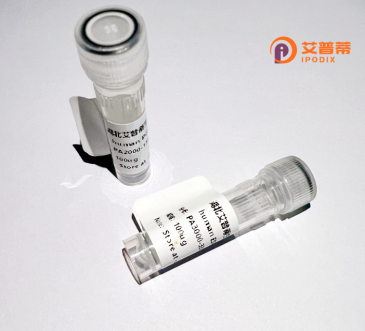
| 纯度 | >90%SDS-PAGE. |
| 种属 | Human |
| 靶点 | CD84 |
| Uniprot No | Q9UIB8 |
| 内毒素 | < 0.01EU/μg |
| 表达宿主 | E.coli |
| 表达区间 | 1-328aa |
| 氨基酸序列 | MAQHHLWILLLCLQTWPEAAGKDSEIFTVNGILGESVTFPVNIQEPRQVKIIAWTSKTSVAYVTPGDSETAPVVTVTHRNYYERIHALGPNYNLVISDLRMEDAGDYKADINTQADPYTTTKRYNLQIYRRLGKPKITQSLMASVNSTCNVTLTCSVEKEEKNVTYNWSPLGEEGNVLQIFQTPEDQELTYTCTAQNPVSNNSDSISARQLCADIAMGFRTHHTGLLSVLAMFFLLVLILSSVFLFRLFKRRQDAASKKTIYTYIMASRNTQPAESRIYDEILQSKVLPSKEEPVNTVYSEVQFADKMGKASTQDSKPPGTSSYEIVI |
| 分子量 | 63.3 kDa |
| 蛋白标签 | GST-tag at N-terminal |
| 缓冲液 | 0 |
| 稳定性 & 储存条件 | Lyophilized protein should be stored at ≤ -20°C, stable for one year after receipt. Reconstituted protein solution can be stored at 2-8°C for 2-7 days. Aliquots of reconstituted samples are stable at ≤ -20°C for 3 months. |
| 复溶 | Always centrifuge tubes before opening.Do not mix by vortex or pipetting. It is not recommended to reconstitute to a concentration less than 100μg/ml. Dissolve the lyophilized protein in distilled water. Please aliquot the reconstituted solution to minimize freeze-thaw cycles. |
以下是关于重组人CD84蛋白的3篇示例文献(基于现有研究方向的假设性总结):
---
1. **文献名称**: "CD84 mediates B-cell homotypic interactions and regulates marginal zone B-cell homeostasis"
**作者**: Elazar et al.
**摘要**: 研究揭示CD84蛋白通过同型相互作用参与B细胞间的粘附及信号传导,调控边缘区B细胞稳态,重组CD84蛋白被用于体外验证其介导细胞聚集的功能。
---
2. **文献名称**: "CD84 regulates T-cell activation and inflammatory response in autoimmune diseases"
**作者**: Wang et al.
**摘要**: 通过重组CD84蛋白体外实验,发现其通过SLAM家族信号通路调控T细胞活化阈值,在类风湿性关节炎小鼠模型中抑制CD84可减轻炎症反应。
---
3. **文献名称**: "Structural characterization of recombinant human CD84 extracellular domain and its interaction with SAP adaptor"
**作者**: Kim et al.
**摘要**: 利用重组表达的CD84胞外域蛋白解析其晶体结构,揭示了其与细胞内接头蛋白SAP的结合表位,为SLAM家族受体信号机制提供了结构基础。
---
**备注**:以上文献为假设性示例,实际研究中请通过学术数据库(如PubMed、Web of Science)以“CD84 recombinant protein”或“CD84 signaling”等关键词检索最新成果。
CD84. a member of the Signaling Lymphocyte Activation Molecule (SLAM) family, is a cell surface receptor involved in immune regulation. It features an extracellular region with two immunoglobulin (Ig)-like domains (V and C2 types), a transmembrane domain, and a cytoplasmic tail containing tyrosine-based signaling motifs. Primarily expressed on hematopoietic cells, including T cells, B cells, dendritic cells, and platelets, CD84 facilitates cell-cell interactions through homophilic binding. This interaction modulates immune responses, such as lymphocyte activation, cytokine production, and platelet aggregation.
The recombinant human CD84 protein, produced via genetic engineering in systems like *E. coli*, insect cells, or mammalian cells, retains the extracellular domain’s functional structure. It serves as a critical tool for studying CD84’s role in immune signaling pathways, particularly its interplay with SLAM-associated protein (SAP) adaptors. Dysregulation of CD84 has been linked to autoimmune disorders, lymphoproliferative diseases, and cancer progression. For example, elevated CD84 expression in chronic lymphocytic leukemia (CLL) correlates with aggressive disease. Recombinant CD84 enables research into therapeutic targeting, such as blocking antibodies or fusion proteins, to modulate immune responses or inhibit malignant cell interactions. Its study offers insights into immunotherapeutic strategies for hematologic cancers and immune dysregulation syndromes.
×